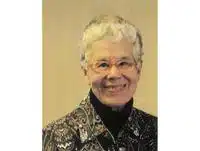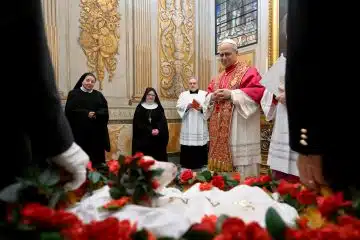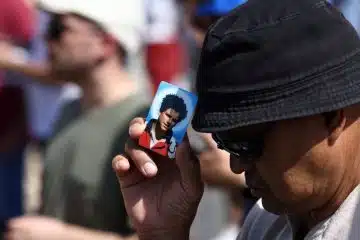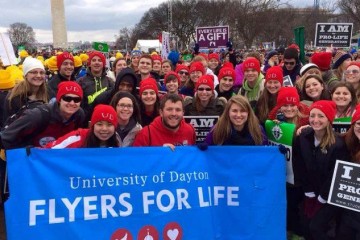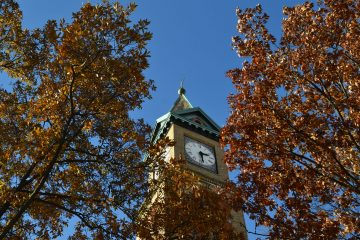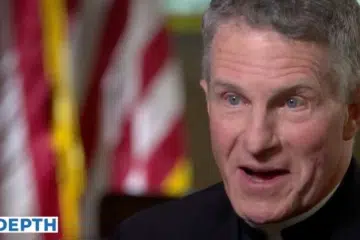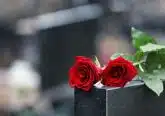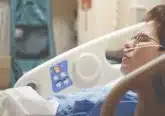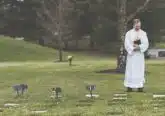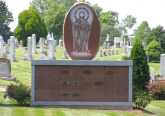Catholic Cemetery Society offers help on stressful subject

By Steve Trosley
The Catholic Telegraph
Maybe your family has been charged with an urn containing the ashes of great-uncle Louis or grandma Helen. For a time, perhaps they rested on the mantle or in a china cabinet. After a while, they were reverently moved to a storage closet or basement shelf.
Unfortunately and often for innocent reasons, those circumstances are not consistent with the teachings of the Catholic Church.
“We understand,” Stephen Bittner, president of the Cincinnati Catholic Cemetery Association said. “That’s why we’re making an effort to educate people about the Church’s teachings on final disposition of the deceased.”
The Society manages three Catholic cemeteries among other functions: St. John, St. Joseph and St. Mary.
“That’s why we’ve been advertising our free cremation burial program for Catholic families,” Bittner explained. “Sometimes the container of ashes gets passed on to family members and they just don’t know what to do about them. Often, too, the person who ends up with the ashes didn’t plan on it so doesn’t have the financial resources to place them in a cemetery, columbarium or mausoleum.
“We will bury them for free, our land and our labor,” Bittner said. “This means they will be in a catholic cemetery, in consecrated grounds, and logged in our records, in accordance with the teachers of the Church and Canon Law.” Bittner added that a memorial marker can be added, but is not free.
Because the church approved cremation after Vatican II and because it is a more inexpensive means of final disposition of the body, the interest in that method has become increasingly popular. (The church says cost is not an acceptable reason for choosing cremation; it also says those who choose cremation to make a religious statement or express a denial of the Catholic teaching on the dignity of the body is also not acceptable.)
Bittner said because humans are by nature a “copy-cat” species, cremation has become more frequently requested and more generally accepted. But he reminds Catholics: “Since in Baptism the body was marked with the seal of the Holy Trinity and it became a temple of the Holy Spirit, Christians respect and honor the bodies of the dead and the places where they rest.
“Full-body burial is preferred by the Church because it reflects more fully the Catholic belief in the bodily resurrection of the dead and our respect for the body as a temple of the Holy Spirit, even after a person’s death.”
Bittner said the inurnment program has been well received, but he suspects there are many who hesitate to take advantage of it for personal reasons. “We’re not here to judge,” he said. “We’re here to help.”
“A Catholic Cemetery is an extension of the Church’s hands,” he said. “We’re just like the Catholic schools, hospitals and other church institutions. We would hope that Catholics would show loyalty to their faith by choosing to work with us at a Catholic cemetery.”
To make that easier, the society has a Family Assistance Program for families of need, Bittner explained.
“We cannot pay the funeral home and we do not operate a funeral home here,” he said. “But we can work with a family to reduce the cost and we will if asked help the family make similar arrangements with a local funeral home.”
He said there is also an intangible benefit of choosing a Catholic cemetery. “We have people who come here who have outlived their family and friends. That’s happening more and more these days. If they come to us, their rite of committal will not be unattended. We will be there to join in the prayers and witness the interment.”
“We also have Catholics who come to us and ask if they can be buried here because they say, ‘ I have not been in a church in 20 years.’ We are not here to judge. We are here to ensure that the burial is conducted in the proper and prayerful manner.”
Bittner advises that families avoid the painful and stressful decisions about burial rites by considering a pre-planning route.
“We have a program that goes over five years – 60 months – with no interest, for the cemetery services, “ Bittner said. “And we can help fund the funeral home costs with an insurance vehicle. That way individuals can make their plan, have control and use the funeral home of their choice.”
‘We have to remember that the Lord doesn’t promise tomorrow,” Bittner said. “We can’t function if that’s all we think about, but it’s a great reflection point from time to time,” he said. “As society has become more acclimated to things disposable, it’s become easy to accept the idea of the disposable body,” Bittner said. “That’s why we offer so many acceptable options to those who may wish to scatter ashes on the sea or at home plate in Great American Ballpark,” he laughed.
(The Catholic Church says in the Order or Christian Burials that the practice “of scattering cremated remains at sea, from the air, on the ground or keeping the cremated remains in the home of a relative or friend for the deceased is not the reverent disposition that the Church requires.”)
“We have a garden area, a columbarium, niches with a glass covering so that a decorative urn can be viewed, and even areas near woods,” he said. “We want to make the surroundings pleasant so that people will visit. That’s something that has really fallen off, other than on events like Memorial Day ceremonies, Easter Sunrise Services, tours and classes that we present.
The St. Joseph Cemetery allows Seton and Elder Cross-Country track teams to use the cemeteries. “We find that gives younger people time to reflect and helps make them more relaxed with visiting the deceased of their families.”
Bittner, who started cutting grass at the cemetery in St. Bernards, became a full-time employee of the Cemetery Society when he completed college. At age 63 with more than 40 years in the Society’s service, he is intimately connected to the Society’s cemetery properties.
“We have space for another 50 years at our current rate of usage. And we have another 20 acres of woods we have not used yet and we have a plan on file to convert that woods to a plateau as needed,” he said. “It takes an hour for me to show what we have here,” he said.
Beyond Cincinnati, he is treasurer of the board of the U.S. Catholic Cemetery Conference and has served on the state board that regulates cemeteries three separate times.
He sees the role of the Catholic cemetery like the gift cross he presents to those who use the society’s services.
“It’s made from stone from Jerusalem. One side is rough and unfinished. The other is smooth. The rough side represents the life the deceased lead before death; the smooth side the new life beyond the grave.”
The cross comes apart and the survivors are offered an opportunity to write a note to their loved one on the smooth side to place in the casket or the urn chamber. The rough side is kept as a remembrance.
“We get many thank-yous for that gift,” he said. “It offers a great explanation of what committal is about and that is a comfort.”
This story originally appeared in the February 2015 print edition of The Catholic Telegraph.


